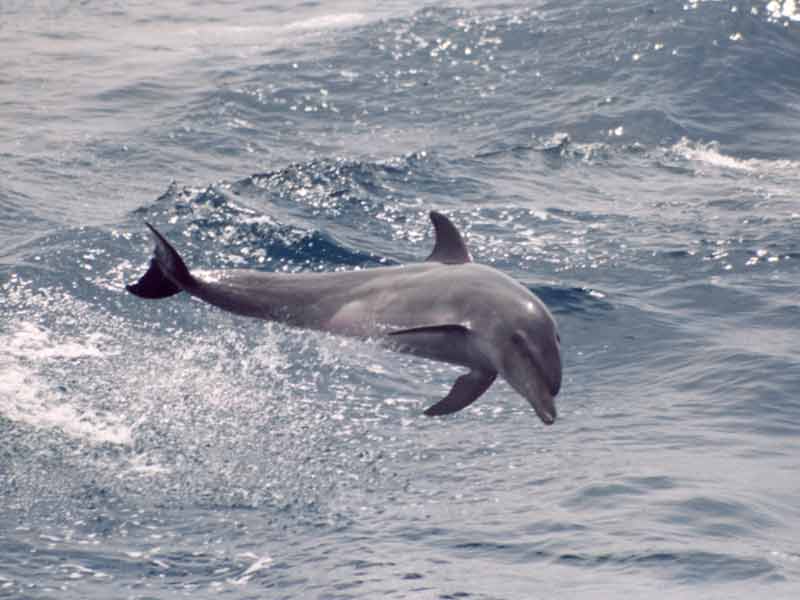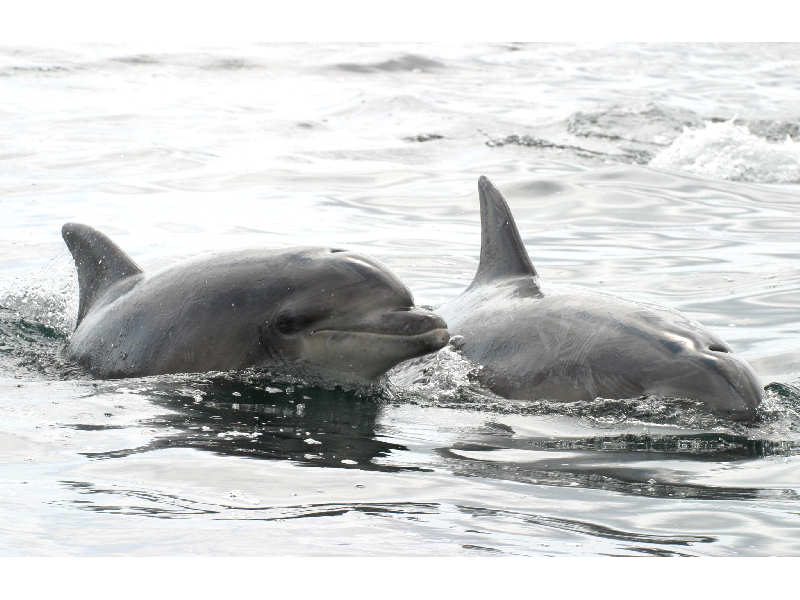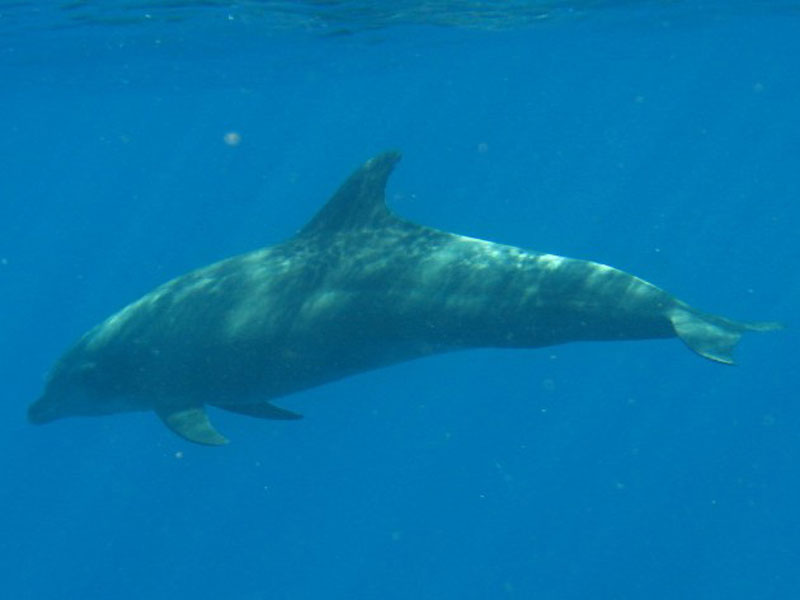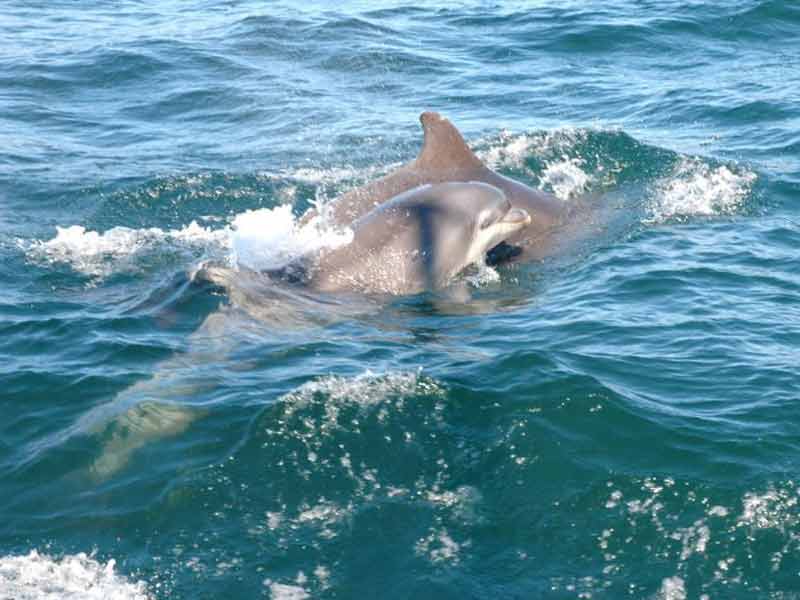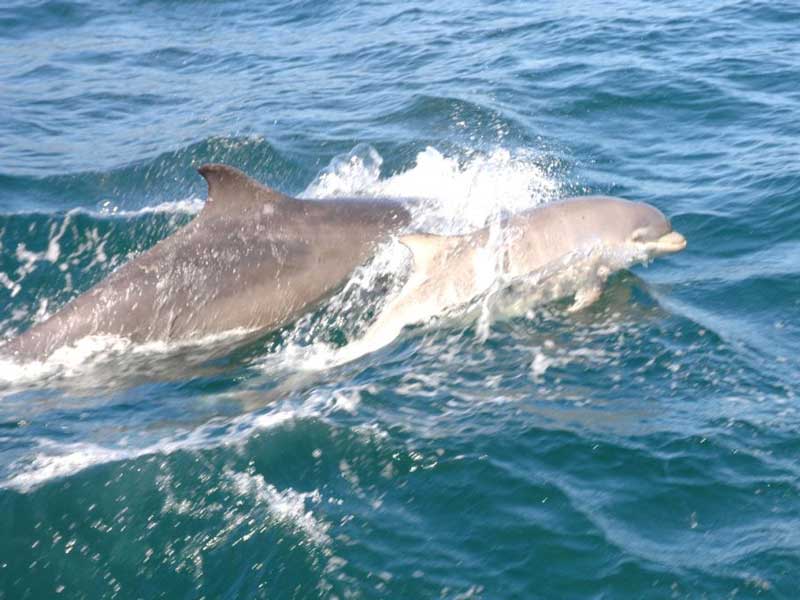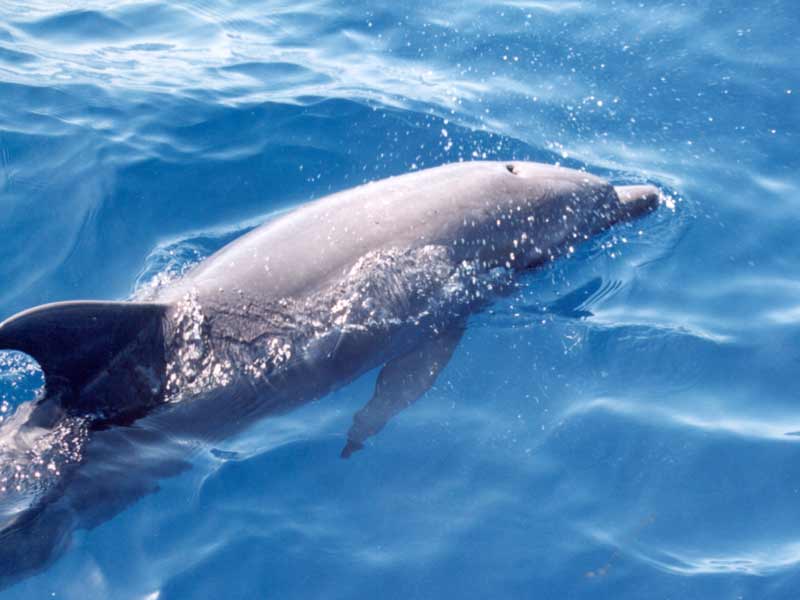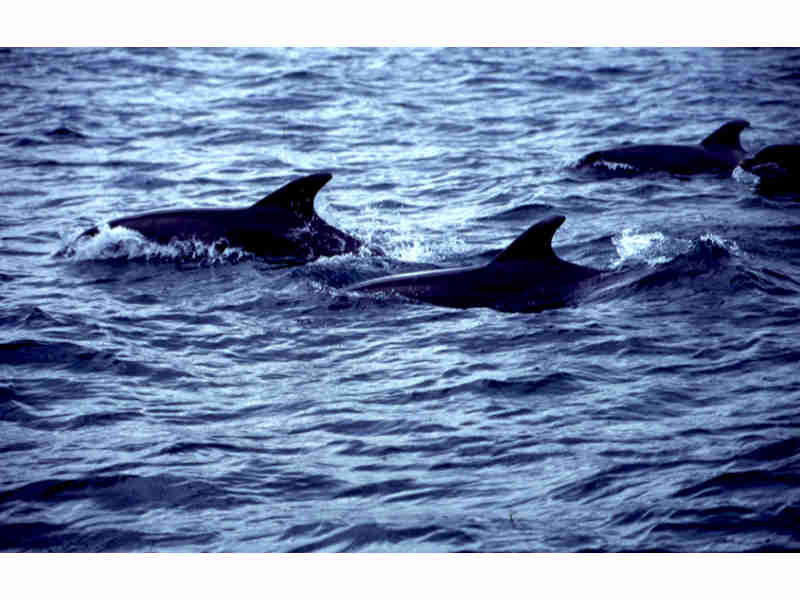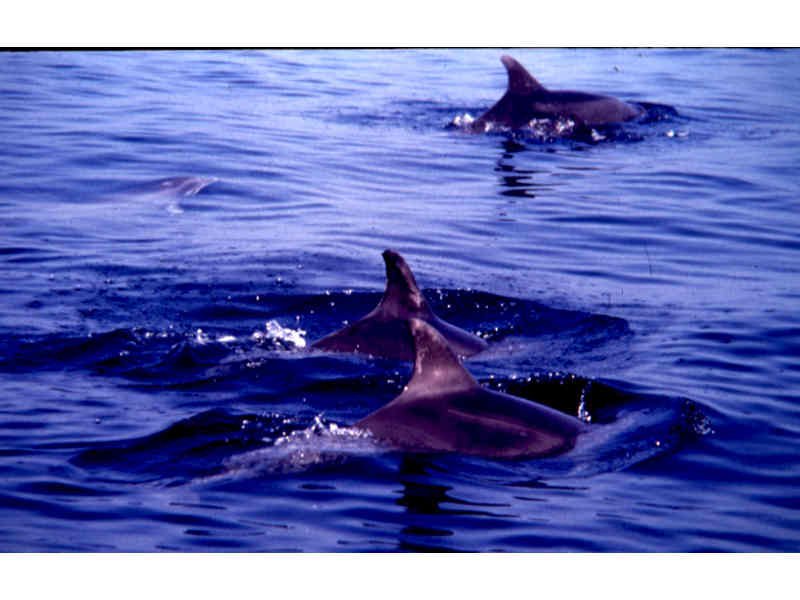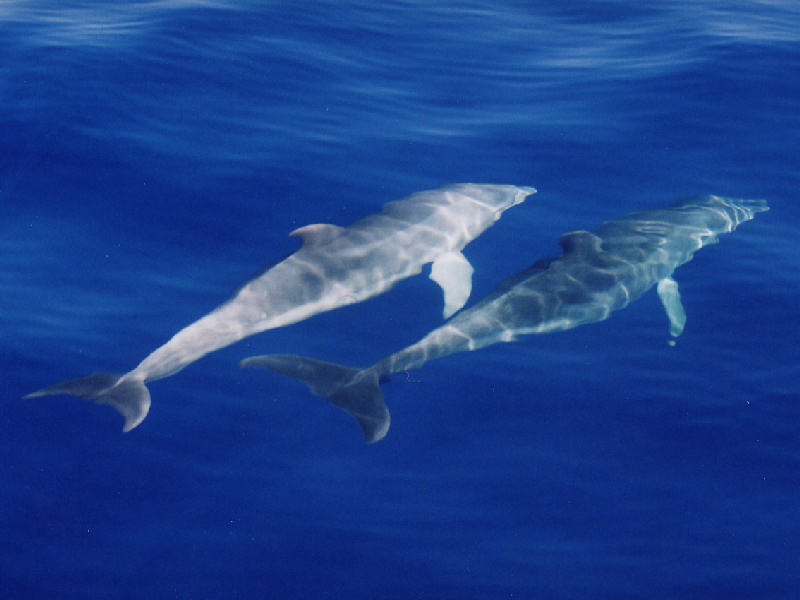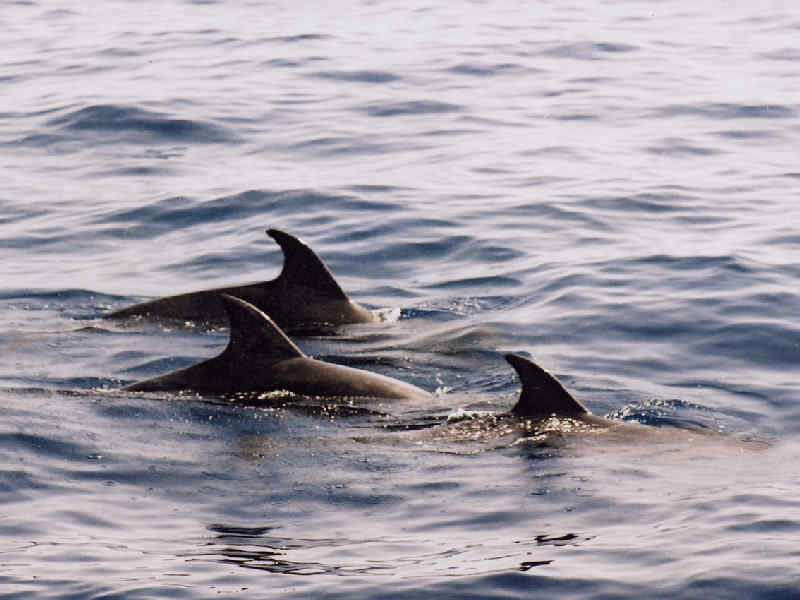Common bottlenose dolphin (Tursiops truncatus)
Distribution data supplied by the Ocean Biodiversity Information System (OBIS). To interrogate UK data visit the NBN Atlas.Map Help
| Researched by | Penny Avant | Refereed by | This information is not refereed |
| Authority | (Montagu, 1821) | ||
| Other common names | Bottlenosed dolphin, Bottlenose dolphin, Bottle-nosed dolphin | Synonyms | - |
Summary
Description
Tursiops truncatus is a large dolphin up to 4 m long, with a dark to light grey back that fades to white on its underside and a dark stripe from eye to flipper. It has a pronounced snout and the lower jaw protrudes in front of the upper. The dorsal fin is tall and backward-curving from the middle of the back. There are between 18 - 26 pairs of large teeth in each jaw. Dolphins regularly surface to breathe, the maximum time spent under water being about 7 minutes.
Recorded distribution in Britain and Ireland
Resident populations are known from Cardigan Bay in west Wales, the Moray Firth in east Scotland and the west coast of Ireland. Also recorded off the south and southwest coasts of England, the western Isles of Scotland and in the Irish Sea.
Global distribution
Occurs worldwide, primarily in coastal and inshore regions of tropical and temperate waters and occasionally in offshore waters such as the eastern Pacific. Generally not found outside latitude 45 degrees except around Britain and northern Europe.
Habitat
Tursiops truncatus is commonly found in coastal waters and along main shipping routes. The population density appears to be higher inshore and dolphins may be found from deep coastal waters into the shallow water off river entrances, but not in freshwater.
Depth range
-Identifying features
- Light to dark grey above with paler underbelly.
- Up to about 4 m long.
- Torpedo shaped body with tall, backward curving dorsal fin.
- The short stubby beak is distinct from the curving head.
Additional information
There is considerable variation in size and colour between populations of Tursiops truncatus worldwide. The European bottle-nosed dolphin tends to be larger and browner than those in the west Altlantic. Group size is commonly less than 20, but groups of over 1000 have been recorded offshore. For information on how to report dolphin sightings see 'Sealife Signpost'.
Tursiops truncatus is listed in the UK Biodiversity Action Plan list of species of conservation concern (Biodiversity Steering Group, 1995). All species of cetaceans are given protection under the Wildlife and Countryside Act 1981 and the Wildlife (Northern Ireland) Order 1985. All cetacean species are listed on Annex A of EU Council Regulation 338/97 and therefore treated by the EU as if they are on CITES Appendix I thus prohibiting their commercial trade. The bottle-nosed dolphin is listed in Annex II and IV (Animal and Plant Species of Community Interest in Need of Strict Protection) of the EC Habitats Directive. Under Annex IV the keeping, sale or exchange of the species is banned, as well as deliberate capture, killing or disturbance. The Directive requires that member states monitor the incidental capture and killing of all dolphins. Marine Special Areas of Conservation (SACs) for bottle-nosed dolphins are being established in the Moray Firth in north-east Scotland, and in Cardigan Bay in west Wales. An 'Agreement on the Conservation of Small Cetaceans in the Baltic and North Seas' (ASCOBANS), formulated in 1992, has now been signed by seven European countries, including the UK. The Agreement makes provision for protection of specific areas, monitoring, research, information exchange, pollution control and heightening public awareness. The North and Baltic Sea populations of the bottle-nosed dolphin are included on Appendix II of the Bonn Convention. (Anon, 1999e).
A report on dolphins in the south west of England (Marine Connection & Wildlife Trusts, 2007) reveals a significant decline in the number of sightings of the bottle-nosed dolphin since 2000.
Listed by
Bibliography
Anonymous, 1999e. Small dolphins. Grouped Species Action Plan. http://www.ukbap.org.uk/UKPlans.aspx?ID=337, 2002-01-25
Biodiversity Steering Group, 1995. Biodiversity: the UK Steering Group report, vol. 1 & 2. London: HMSO.
Bruyns, W.F.J.M., 1971. Field guide of whales and dolphins. Amsterdam: Publishing Company Tors.
Howson, C.M. & Picton, B.E., 1997. The species directory of the marine fauna and flora of the British Isles and surrounding seas. Belfast: Ulster Museum. [Ulster Museum publication, no. 276.]
Jefferson, T.A., Leatherwood, S. & Webber, M.A., 1994. FAO species identification guide. Marine mammals of the world. Rome: United Nations Environment Programme, Food and Agriculture Organization of the United Nations.
Marine Connection & Wildlife Trusts, 2007. The south west dolphin report.
Datasets
Bristol Regional Environmental Records Centre, 2017. BRERC species records recorded over 15 years ago. Occurrence dataset: https://doi.org/10.15468/h1ln5p accessed via GBIF.org on 2018-09-25.
Cofnod – North Wales Environmental Information Service, 2018. Miscellaneous records held on the Cofnod database. Occurrence dataset: https://doi.org/10.15468/hcgqsi accessed via GBIF.org on 2018-09-25.
Dumfries and Galloway Environmental Resources Centre, 2017. Mammal records for Dumfries and Galloway. Occurrence dataset: https://doi.org/10.15468/oirkpx accessed via GBIF.org on 2018-09-27
Environmental Records Information Centre North East, 2018. ERIC NE Combined dataset to 2017. Occurrence dataset: http://www.ericnortheast.org.ukl accessed via NBNAtlas.org on 2018-09-38
Fife Nature Records Centre, 2018. Fife Nature Records Centre combined dataset. Occurrence dataset: https://doi.org/10.15468/ccc1ip accessed via GBIF.org on 2018-09-27.
Fife Nature Records Centre, 2018. St Andrews BioBlitz 2015. Occurrence dataset: https://doi.org/10.15468/xtrbvy accessed via GBIF.org on 2018-09-27.
Hebridean Whale and Dolphin Trust, 2018. Visual sightings data set 2003-2017. Occurrence dataset: https://hwdt.org/ accessed via NBNAtlas.org on 2018-09-27.
Isle of Wight Local Records Centre, 2017. Isle of Wight Notable Species. Occurrence dataset: https://doi.org/10.15468/sm4ety accessed via GBIF.org on 2018-09-27.
John Muir Trust, 2017. Species Records for John Muir Trust Properties Nevis, Sandwood, Quinag and Schiehallion 2010.. Occurrence dataset: https://doi.org/10.15468/n9dwn0 accessed via GBIF.org on 2018-09-27.
Manx Biological Recording Partnership, 2017. Isle of Man wildlife records from 01/01/2000 to 13/02/2017. Occurrence dataset: https://doi.org/10.15468/mopwow accessed via GBIF.org on 2018-10-01.
Merseyside BioBank., 2017. Merseyside BioBank (verified). Occurrence dataset: https://doi.org/10.15468/ar0p6s accessed via GBIF.org on 2018-10-01.
National Trust, 2017. National Trust Species Records. Occurrence dataset: https://doi.org/10.15468/opc6g1 accessed via GBIF.org on 2018-10-01.
NBN (National Biodiversity Network) Atlas. Available from: https://www.nbnatlas.org.
Norfolk Biodiversity Information Service, 2017. NBIS Records to December 2016. Occurrence dataset: https://doi.org/10.15468/jca5lo accessed via GBIF.org on 2018-10-01.
North East Scotland Biological Records Centre, 2017. NE Scotland marine mammal records 1800-2010. Occurrence dataset: https://doi.org/10.15468/suphju accessed via GBIF.org on 2018-10-01.
OBIS (Ocean Biodiversity Information System), 2025. Global map of species distribution using gridded data. Available from: Ocean Biogeographic Information System. www.iobis.org. Accessed: 2025-07-01
Outer Hebrides Biological Recording, 2018. Vertebrates (except birds, INNS and restricted records), Outer Hebrides. Occurrence dataset: https://doi.org/10.15468/dax3tf accessed via GBIF.org on 2018-10-01.
South East Wales Biodiversity Records Centre, 2018. SEWBReC Mammals (South East Wales). Occurrence dataset: https://doi.org/10.15468/atlxpp accessed via GBIF.org on 2018-10-02.
South East Wales Biodiversity Records Centre, 2018. Dr Mary Gillham Archive Project. Occurance dataset: http://www.sewbrec.org.uk/ accessed via NBNAtlas.org on 2018-10-02
Suffolk Biodiversity Information Service., 2017. Suffolk Biodiversity Information Service (SBIS) Dataset. Occurrence dataset: https://doi.org/10.15468/ab4vwo accessed via GBIF.org on 2018-10-02.
The Mammal Society., 2017. National Mammal Atlas Project, online recording. Occurrence dataset: https://doi.org/10.15468/i2eosa accessed via GBIF.org on 2018-10-02.
West Wales Biodiversity Information Centre, 2018. Seatrust Cetacean Records West Wales. Occurrence dataset: https://doi.org/10.15468/ecsmqh accessed via GBIF.org on 2018-10-02.
Whale and Dolphin Conservation, 2018. WDC Shorewatch Sightings. Occurrence dataset: https://doi.org/10.15468/9vuieb accessed via GBIF.org on 2018-10-02.
Citation
This review can be cited as:
Last Updated: 03/07/2008

